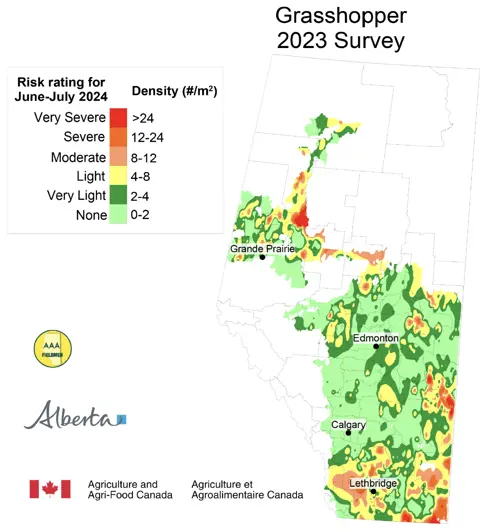Cereal Pests to Watch Out For in 2024
In 2023, we saw significant grasshopper and wheat stem sawfly damage in Alberta. As the 2024 season begins, what is the outlook like for cereal insect pests and which ones need special attention?

Grasshoppers
2023 saw lots of grasshoppers and while we did not see a widespread outbreak, some areas experienced severe crop damage. The Prairies especially have seen higher grasshopper numbers over a wider area in the last few years.
If conditions remain dry, the outlook for 2024 is concerning for any of the 2023 hot spots. Due to the warm and dry weather we experienced in the spring of 2023, grasshopper hatch and development was approximately 2 weeks earlier than average. Second and third instar nymphs were reported east of Medicine Hat on May 18, 2023, and the first grasshopper adults were found in Stand Off area on June 18, 2023, rather than in early July as expected on an average year. For this reason, the grasshoppers had ample time to lay eggs and embryo development is expected to be advanced due to the warm, dry fall. Once spring conditions become favourable and soil temperatures reach 10 degrees Celsius, a lot of hatching can be expected.
Scouting early and often is the key to managing grasshoppers. Begin scouting in early May, as grasshopper embryos will break diapause and finish development as the weather gets warmer. Closely monitor any 2023 hot spots and any spots with early vegetation growth, such as roadsides or ditches. Control grasshoppers early when their population is over the threshold for your crop type and conditions.
The grasshopper species most responsible for crop loss in Alberta are the two-striped grasshopper, migratory grasshopper, packard's grasshopper, clear-winged grasshopped, and bruners grasshopper.
For more information on grasshopper identification and management, please visit the Alberta Agriculture and Irrigation Grasshopper Overview.

Wheat Stem Sawfly
In southern Alberta especially, wheat stem sawfly densities have been trending up in the last few years. There is a parasitoid, Bracon cephi, that is very effective in decreasing sawfly population over time, that unfortunately is largely wasted in years where the wheat harvest starts early due to drought meaning fewer sawflies are attacked.
If it continues to be warm and dry, wheat stem sawfly is expected to be an issue in the same areas as in 2023. If over 10-15% cutting ws observed in fall 2023, growers are encouraged to plant a solid stem variety. Solid stem varieties can reduce cutting by up to 90%, while also reducing the survival of eggs the following year.
For more information on wheat stem sawfly management, click here.

Wheat Midge
Wheat midge needs moisture in May and June in order to survive and develop into adults, meaning midge risk was relatively low in 2023. Higher populations were only seen in areas where spring rain was present. However, in areas like the Peace Region that did not receive sufficient rain, midge can stay dormant in the soil for several years.
Do not overlook the risks of midge in 2024, whether or not your area has sufficient spring moisture or otherwise. Refer to Prairie Pest Monitoring Network for weekly forecast maps and the Alberta Pest Monitoring Network for the wheat midge emergence trap network results. Crops are most susceptible to wheat midge when egg laying occurs from boot crack to the end of anthesis. Add midge to your scouting list when your crop is at the susceptible stage.
Contact Us
Saddle Hills
Junction of Hwy 49 & Secondary Hwy 725
RR1, Spirit River AB
T0H 3G0
T. 780-864-3760
Fax 780-864-3904
Toll-free 1-888-864-3760
frontdesk@saddlehills.ab.ca
Sign up to our Newsletter
Stay up to date on the Saddle Hills activities, events, programs and operations by subscribing to our eNewsletters.
